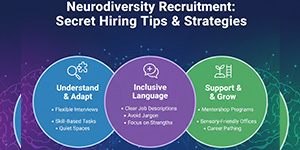What is the Hiring Process and How to Speed It Up?
The hiring process is an important part of any business because it affects how well the company can find, assess, and hire top talent. Whether you're a business owner, an HR worker, or a hiring manager, you need to know how the hiring process works and how to make it better in order to build a strong team.
This article will talk about what is hiring process, how it works, and ways to speed it up while reducing bias.
 |
What is Hiring Process?The systematic way that companies find, rate, choose candidates for open jobs is called the hiring process. It includes everything from describing the job to getting the new employee up to speed. |
A well-organized hiring process makes sure that the company gets the right people who will fit in with its goals, values.
The steps below are usually part of the hiring process:
- Identifying the Hiring Need: This is the first step. A department or team finds a job opening, asks for a new employee.
- Job Description Creation: The person in charge of hiring or human resources writes a detailed job description that lists the duties, requirements, standards of the position.
- Sourcing Candidates: This means finding possible candidates through job postings, word of mouth, social media or recruitment companies.
- Screening and Shortlisting: Resumes, applications are looked over to find the best candidates who meet the job standards.
- Interviews: Those who made the short list are asked to see how well they fit in with the company's culture, skills and experience.
- Assessment and Testing: Some companies use tests, assignments or assessments to figure out how qualified job prospects are.
- Reference and Background Checks: Employers check a candidates qualifications, work history.
- Job Offer: A written job offer is made to the person who was chosen.
- Onboarding: Orientation and training help the new employee become part of the company.
The first thing that needs to be done to make the hiring process better is to know what is hiring process. Let's talk more about how to speed up the hire process.
How Does the Hiring Process Work?
The hiring process can be different for each company based on its size, industry, and needs. But most businesses have an organized workflow, which can be seen in a hiring process flowchart. This plan shows each step, making sure that everything is clear and consistent.
A normal HR hiring process might look something like this:
- Recruitment Planning: HR works with department heads to describe the job, what it needs.
- Candidate Sourcing: HR uses job board, LinkedIn, employee recommendations, among other places, to find applicants.
- Application Review: Human Resources looks over papers, applications to find good candidates.
- Interview Coordination: Human Resources plans and runs interviews which usually have more than one round.
- Decision-Making: HR and hiring managers look at candidates and choose the best fit.
- Offer and Onboarding: HR makes the job offer and handles the hiring process.
The recruitment process in HR is meant to be fair and quick but it can take a long time and be hard to use. Let's look into ways to make it go faster without losing quality.
How to Speed Up the Hiring Process
A slow hiring process can cause you to lose top workers to competitors, give current employees more work to do, and raise the cost of hiring. Here are some ways that hiring process in HRM:
- Make use of technology
Using applicant tracking systems (ATS) and recruitment software can make jobs like screening resumes and setting up interviews that need to be done over and over again easier to do. These tools make it easier for HR teams to handle the hiring process flowchart which cuts down on manual work and speeds up the decision-making process. - Standardize the Process
Making an HR hiring process that is consistent and cuts down on delays is important. Make clear rules for each step, from offering the job to getting the new employee started, and teach your team how to follow them. A clear recruitment process in HR cuts down on misunderstanding and speeds up the hiring process. - Improve Job Descriptions
Short and clear job descriptions help you find the best people faster and spend less time screening those who aren't qualified. Make it clear what the job requires, what you expect from it, and what you are responsible for. - Conduct Structured Interviews
Structured interviews with set questions help quickly and fairly judge candidates. This method also cuts down on bias, making sure that the hiring process in HRM is fair. - Collaborate with Hiring Managers
HR should work closely with hire managers to make sure that they both know what the job needs and what the candidate expects. Regular contact keeps things on track and avoids delays in the hiring process flowchart. - Use Pre-Employment Assessments
Skills tests or personality tests given early on in the process can help find the best people more quickly. This cuts down on the number of interviews that need to be done. - Streamline Decision-Making
Set up a clear way to make decisions so that the process of choosing people doesn't take too long. Set due dates for feedback and make sure that everyone who needs to be involved can be reached for talks. - Enhance Candidate Experience
A good candidate experience can speed up the hiring process by keeping prospects interested and ready to respond. Talk to each other often, give comments, and be clear about when things need to be done.
By using these tactics, businesses can improve the way they hire process and get the best employees more quickly.
How to Reduce Bias in Hiring Process?
When hiring people, bias can cause unfair choices, less variety and missed chances to hire the best people. In the HR hiring process, here are some ways to get rid of bias:
- Blind Recruitment
Take out personal information like name, gender and age from applications and resumes so that the focus is only on experience and skills. - Diverse Hiring Panels
Involve a variety of interviewers from different backgrounds in the recruitment process in HR to get different points of view, lessen personal bias. - Interviews with a Plan
As we already said structured interviews with standard questions help make decisions about people more objectively by reducing the need for subjective opinions. - Bias Training
Teach HR and hiring managers how to spot, deal with unconscious bias in the hiring process in HRM. - Data-Driven Decisions
Don't rely on your gut feelings or personal preferences when judging a candidate's success and potential. Instead, use data and analytics. - Clear Evaluation Criteria
Set clear, measurable criteria for each step of the hiring process flowchart to use when judging candidates. This keeps things fair and consistent.
Not only does reducing bias make things more fair, but it also improves the quality of hires, making the workplace more open and creative.
Conclusion
The hiring process is a key part of any organizations growth because it helps them find and keep great employees. It's important for HR workers and hiring managers to know what is hiring process and how it works. Companies can speed up the HR hiring process without lowering quality by using technology making routines more consistent and getting rid of bias.
A well-optimized recruitment process in HR not only saves time and money, but it also makes the job application experience better which makes the company an attractive place to work. The goal is to make a smooth, efficient, and hiring process flowchart that leads to long-term success. This can be done by improving your hiring process diagram or putting in place new strategies to reduce bias.
By focusing on best practices and continuous growth, companies can turn their HRM hiring process into a strategic advantage that helps them hire the right people at the right time.
Read More: A Guide to Jobs in 2024, Cambodia Job Hiring Employment Opportunities





